The Submarines
The Early Development
The submarines that fought the Imperial Japanese Navy in World War II began their development with
|
the boats first built by John P. Holland.
.jpg) Beginning in the 1880s and
continuing through 1900, Holland worked with primarily his own funds to develop
a realistic submersible vessel. His sixth self designed and built craft, the
1987 launched Holland VI, was finally up to his demanding standards. In
April 1900, the U.S. Navy purchased this boat and renamed her, Submarine Torpedo Boat #1 USS Holland[1].
Holland
became the template for all subsequent U.S. Navy submarine development.
Submarines used electric propulsion underwater and were powered by an oxygen
breathing engine of some type on the surface. Submerging and surfacing was
accomplished by flooding ballast tanks[2]
to over come buoyancy. To surfacing, pressurized air was forced into the
ballast tanks to drain them and restore positive buoyancy. Later developments
by John Holland’s rival, Simon Lake included diving planes and periscope[3]
Beginning in the 1880s and
continuing through 1900, Holland worked with primarily his own funds to develop
a realistic submersible vessel. His sixth self designed and built craft, the
1987 launched Holland VI, was finally up to his demanding standards. In
April 1900, the U.S. Navy purchased this boat and renamed her, Submarine Torpedo Boat #1 USS Holland[1].
Holland
became the template for all subsequent U.S. Navy submarine development.
Submarines used electric propulsion underwater and were powered by an oxygen
breathing engine of some type on the surface. Submerging and surfacing was
accomplished by flooding ballast tanks[2]
to over come buoyancy. To surfacing, pressurized air was forced into the
ballast tanks to drain them and restore positive buoyancy. Later developments
by John Holland’s rival, Simon Lake included diving planes and periscope[3]
U.S. submarine development became a mixture of the ideas of Holland and Lake. Initial submarine production of Holland’s designs was even split between Holland’s J.P. Holland Torpedo Boat Company, a subsidiary of Isaac Rice’s Electric Boat Company of Groton Connecticut, and Simon Lake’s Lake Torpedo Boat Company of Bridgeport Connecticut[4]. Later Portsmouth Naval Yard joined as a primary contractor of early submarines.
In October of 1900, the United States Navy became the second nation to buy “modern” submarines by commissioning Holland to build six more 64’ “A” boats.[5] In quick succession the U.S. Navy owned 18 boats.
|
Figure 28. Simon Lake. |
Along with the Holland built
A-class
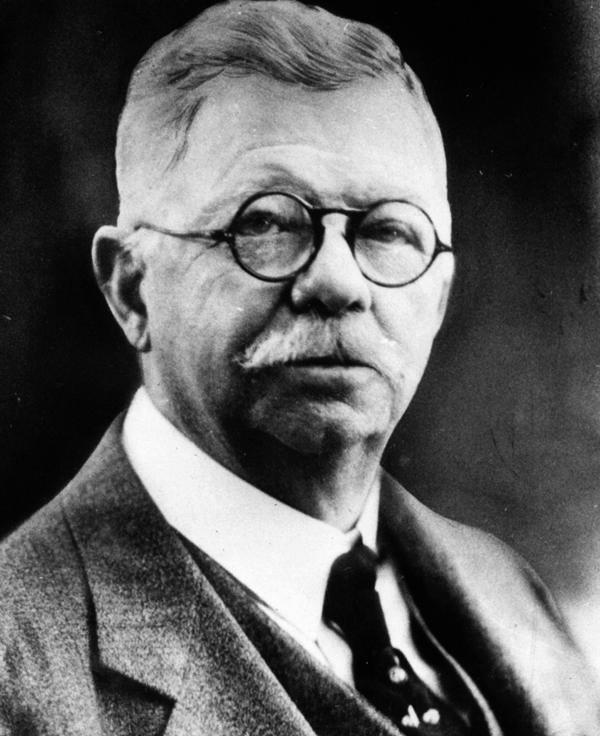 boats with one torpedo tube, came 11 boats built by the Electric Boat
Company, 3 B-class boats (82’, 2 torpedo tubes), 5 C-class boats (105’, 2
torpedo tubes), and 3 D-class boats (135’, 4 torpedo tubes). These boats ran on
gasoline powered engines on the surface with batteries running electric motors
when submerged.[6]
A major draw back with gasoline was the fumes when submerged. When diving, the
gasoline engines were shut down mechanically and still had fuel in the lines and
cylinders. Submerged, the evaporating fuel just in the engine often over came
the engine room crew and on at least one occasion left a young ENS Lockwood’s
entire crew feeling no pain. Lockwood later recalled the need to surface
before being overcome was a rather hazy idea at the time[7]
From 1911 through 1914, the problems with
limited air supply and gasoline fumes drove the switch to diesel engines. These
diesel engines provided more power, better fuel economy, and better safety (no
fumes to ignite). The Navy bought 4 E-class boats, 4 F-class boats,
along with 3 H-class experimental boats, all equipped with diesel engines.
Next came the G-class Lake boats which Simon Lake equipped with wheels to roll across the ocean floor. The
big pre-war built came with the K-class boats. The United States Navy had 17
diesel powered K-boats spread across the globe when war broke out in Europe[8].
The outbreak of war found the United States Navy with 34 submarines (which
ranked it 4th). The Royal Navy held the 2nd largest
submarine fleet submarine fleet in the world (with 72). France fielded 123
submarines and Russia owned 41. Germany, the submarine menace during the war,
began with 26 boats of which 14 were obsolete[9].
boats with one torpedo tube, came 11 boats built by the Electric Boat
Company, 3 B-class boats (82’, 2 torpedo tubes), 5 C-class boats (105’, 2
torpedo tubes), and 3 D-class boats (135’, 4 torpedo tubes). These boats ran on
gasoline powered engines on the surface with batteries running electric motors
when submerged.[6]
A major draw back with gasoline was the fumes when submerged. When diving, the
gasoline engines were shut down mechanically and still had fuel in the lines and
cylinders. Submerged, the evaporating fuel just in the engine often over came
the engine room crew and on at least one occasion left a young ENS Lockwood’s
entire crew feeling no pain. Lockwood later recalled the need to surface
before being overcome was a rather hazy idea at the time[7]
From 1911 through 1914, the problems with
limited air supply and gasoline fumes drove the switch to diesel engines. These
diesel engines provided more power, better fuel economy, and better safety (no
fumes to ignite). The Navy bought 4 E-class boats, 4 F-class boats,
along with 3 H-class experimental boats, all equipped with diesel engines.
Next came the G-class Lake boats which Simon Lake equipped with wheels to roll across the ocean floor. The
big pre-war built came with the K-class boats. The United States Navy had 17
diesel powered K-boats spread across the globe when war broke out in Europe[8].
The outbreak of war found the United States Navy with 34 submarines (which
ranked it 4th). The Royal Navy held the 2nd largest
submarine fleet submarine fleet in the world (with 72). France fielded 123
submarines and Russia owned 41. Germany, the submarine menace during the war,
began with 26 boats of which 14 were obsolete[9].
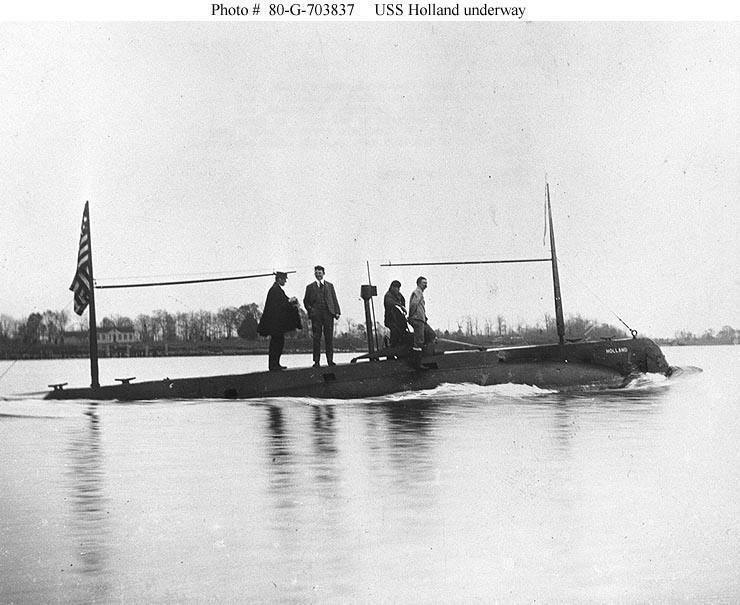
Figure 29. USS Holland (Submarine Torpedo Boat # 1). Underway, circa 1900, probably soon after she was accepted by the Navy.
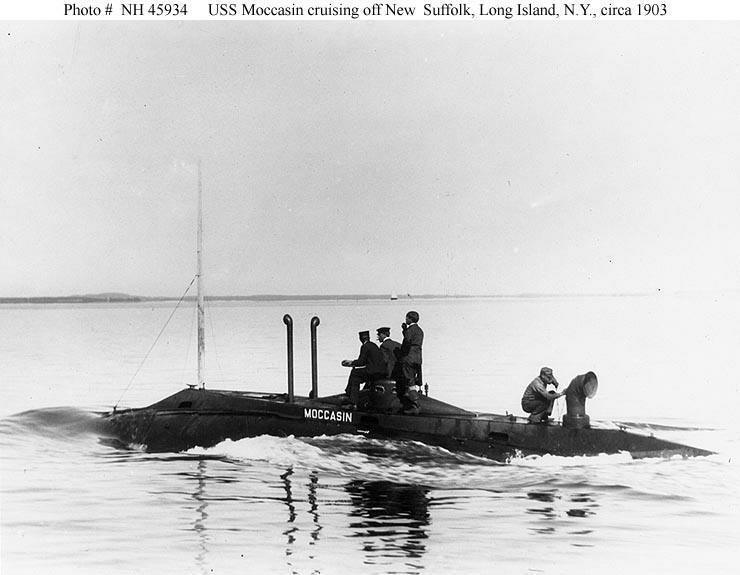
Figure 30. A class submarine USS Moccasin (Submarine # 5).
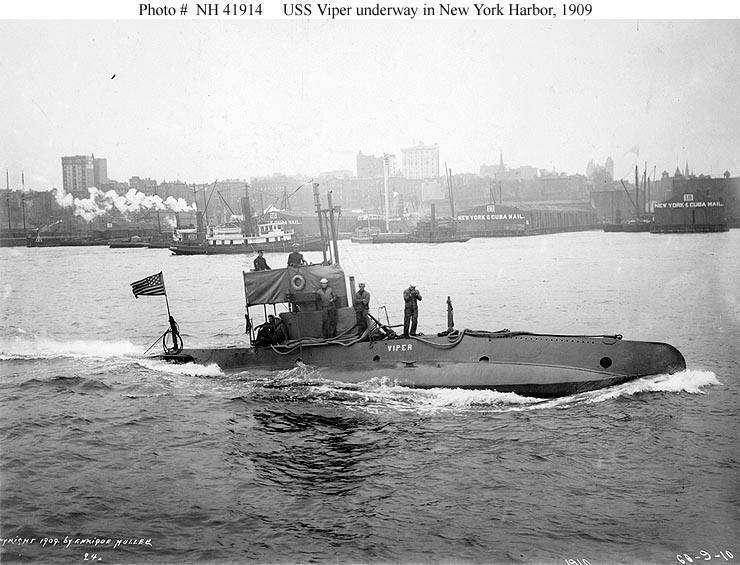
Figure 31. B class submarine USS Viper (Submarine # 10),
1909.
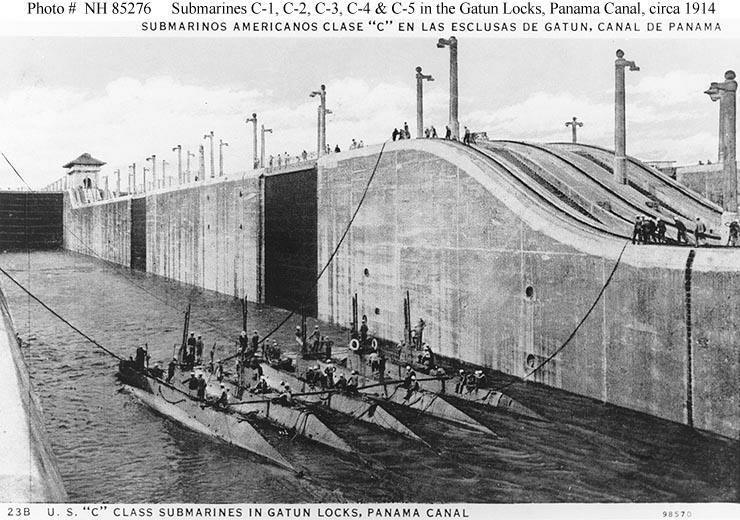
Figure 32. C-Class submarines in the Gatun Locks, Panama Canal, circa 1914.
Photograph printed on a color-tinted postal card, prior to World War I.
The submarine present include (in no particular order): USS C-1
(submarine # 9); USS C-2 (submarine # 13); USS C-3 (submarine #
14); USS C-4 (submarine # 15); and USS C-5 (submarine # 163).
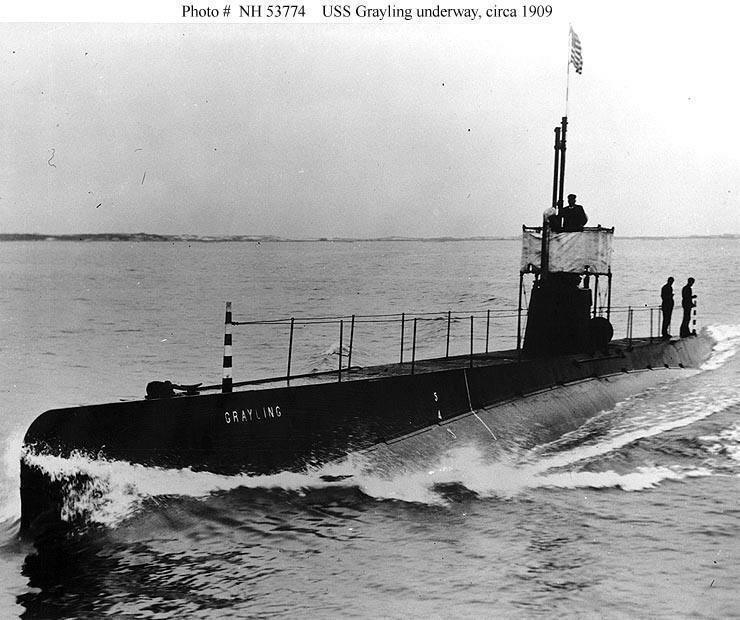
Figure 33. USS Grayling (Submarine # 18, later renamed D-2)

Figure 34. E Type Submarine.
.jpg)
Figure 35.USS E-2 (Submarine # 25)

Figure 36. Lake Built G-4
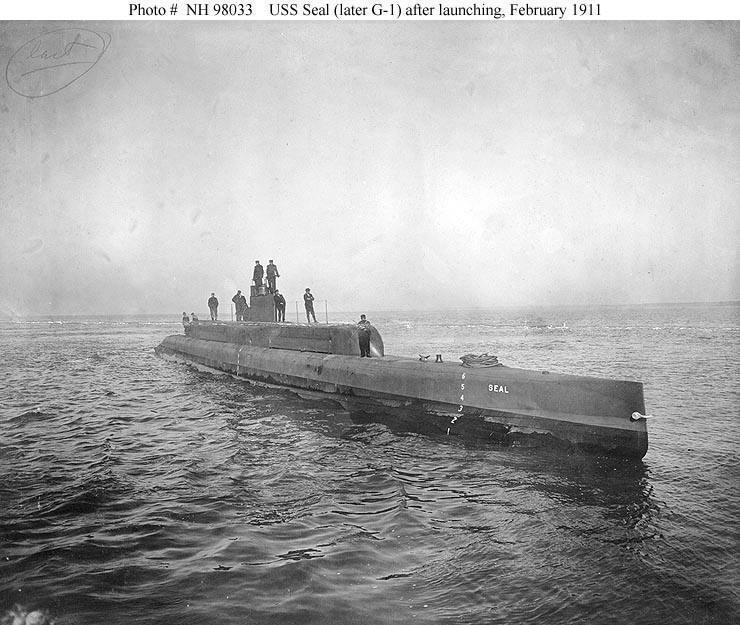
Figure 37. USS Seal (Submarine # 19½) Afloat after launching, off the Newport News Shipbuilding and Dry Dock Company shipyard, Newport News, Virginia, 8 February 1911. Seal was later renamed G-1.

Figure 38.
USS F-3 (Submarine # 22). Underway off San Diego, California, circa
1912. Name changed from Pickerel while under construction
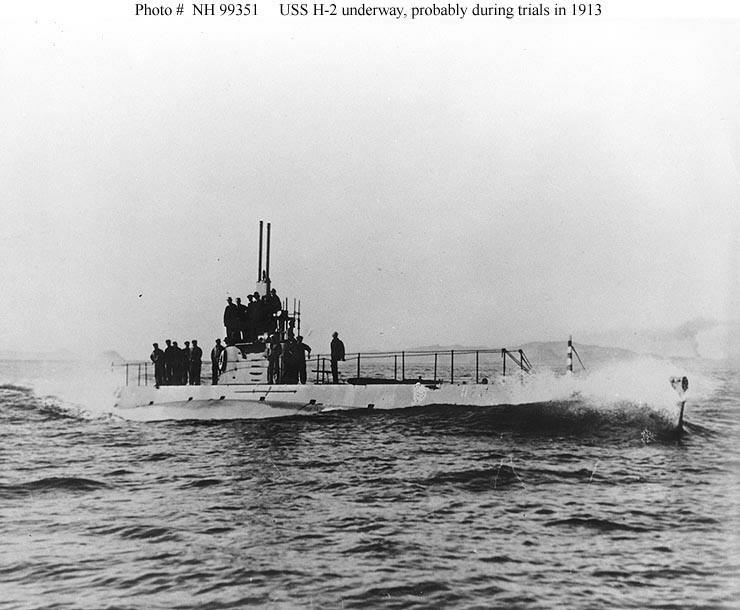
Figure 39.
USS H-2 (Submarine # 29).
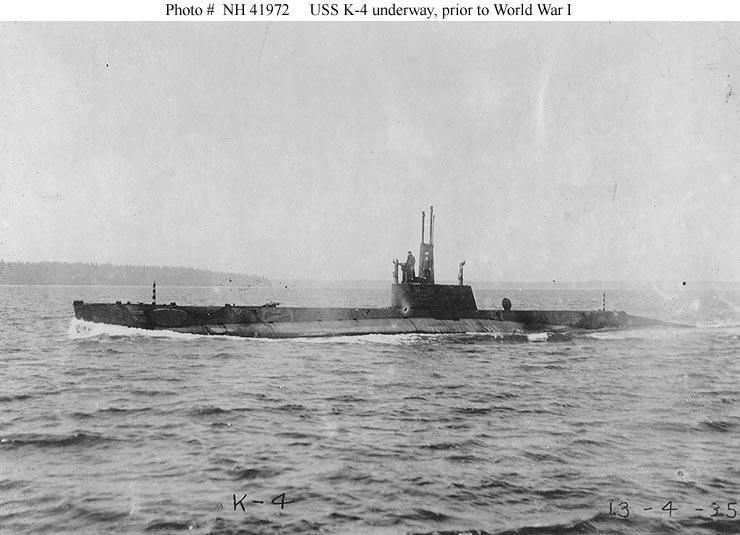
Figure 40. USS K-4 (Submarine # 35), originally named Walrus, but changed to K-4 during construction. Underway prior to World War I, possibly in the Seattle, Washington, area when she was first completed in 1914. Last submarine named until the V-1 class USS Barracuda (SS-163) in 1924.
World War I drove further development of American submarines. Observations of the successful implementation of Untersee boots or U-boats of the German Navy in blockading Great Britain should have shouted to all of the capabilities of such vessels and the tactical doctrine needed. By the time ADM Sims arrived in England in April 1917, the Royal Navy’s First Lord of the Admiralty Sir John Jellicoe admitted the loss rates of merchant shipping were prohibitive[10]. If the United States Navy and the Royal Navy did not stop the U-boat menace, Great Britain would be forced to admit defeat before the year was out.[11]
The Naval Act of 1916 authorized “A Navy Second To None”. Under this law the Navy built 11 L-class boats (considered to be slightly larger improved K-class boats), 1 M-class experimental boat, and 7 N-class boats which were smaller than the K-boats. All of these were built with four bow tubes and room for eight torpedoes. Also included were 43 O-R boats. Like the L class boats, the O- and R-class boats were improved K- and L-boats[12]. Of importance to World War II, are the 51 S-boats authorized. The S-boats were originally intended to be 800 tons, 230’ in length, with four torpedo tubes and room for a total of 12 torpedoes. The S-boats came in two types – Holland and Lake. The Holland S-boats were of the double hull variety with internal ballast tanks. The Lake boats had the external ballast tanks as seen in World War II movies and single hulls[13].
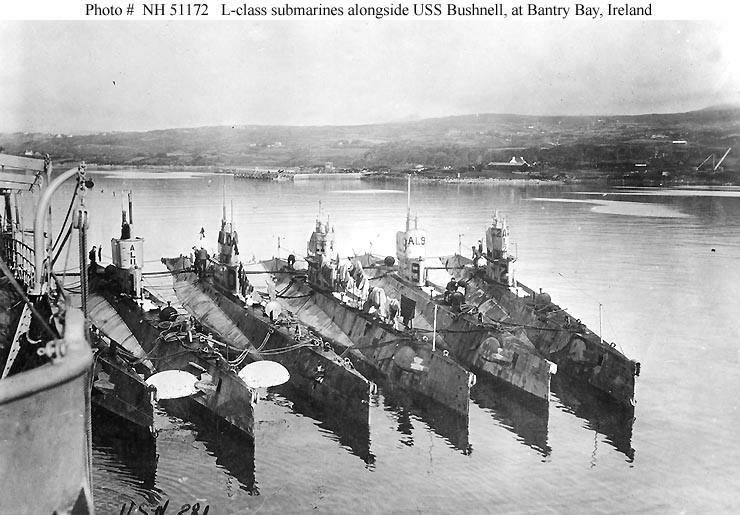
Figure 41. "L" Type Submarines alongside USS Bushnell (Submarine Tender # 2) at Bantry Bay, Ireland, in 1918. These submarines are, from left to right:
unidentified submarine; USS L-11 (Submarine # 51); USS L-10 (Submarine # 50); USS L-1 (Submarine # 40); USS L-9 (Submarine # 49); and USS L-2 (Submarine # 41). Identification marks painted on these "boats"' fairwaters include the letter "A", to distinguish them from British "L" Type submarines.

Figure 42. Submarine Division 8, Commander Guy E. Davis commanding. Nine of the Division's ten "O" type submarines at the Boston Navy Yard, Charlestown, Massachusetts, 16 August 1921. Panoramic photograph by Crosby, "Naval Photographer", 11 Portland Street, Boston. Submarines in the front row are (from left to right): O-3 (SS-64), O-6 (SS-67), O-9 (SS-70) and O-1 (SS-62). Those in the second row are (from left to right): O-7 (SS-68), unidentified (either O-2 or O-8), O-5 (SS-66), O-10 (SS-71) and O-4 (SS-65).
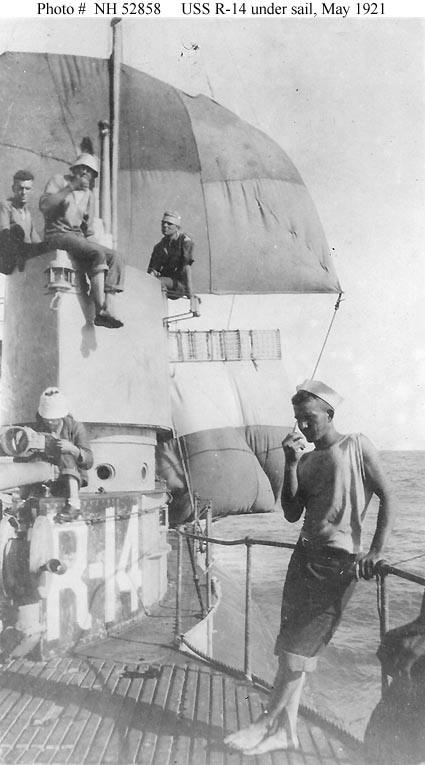
Mahon’s Influence
The major issue of pre World War II submarine development was the primary mission. One group of though aimed development at small submarines less than 1000 tons in surface displacement for coastal defense and other short range uses. The other camp used the holy writs of CAPT Alfred Thayer Mahon to justify development of submarines capable of operating with “The Fleet”. These “Fleet boats” would need a surface speed of at least 17 knots to keep up with fleet movements and have a size capable of carrying enough fuel for fleet operations. Such submarines would displace 2000 tons or more.
The Washington Naval Conference of 1922 sought to prevent renewal of the pre-war naval arms race. The United States declared its intentions of building a navy second to none. Great Britain’s laws required the Royal Navy to be larger than the next two largest navies. Japan, victor over the Imperial Russian Fleet, sought to maintain mastery of the Pacific. With this naval arms race looming on the horizon, the United States initiated the conference to limit tonnages of major combatants.[14]

Figure 44. Submarines nested together, May 1920. Alongside USS Camden (Submarine Tender # 6), in the North River, New York City. They are, from near to far (left to right):
USS R-4 (Submarine # 81); USS R-5 (Submarine # 82); USS R-6 (Submarine # 83); USS R-10 (Submarine # 87); USS R-9 (Submarine # 86); USS R-8 (Submarine # 85); USS R-7 (Submarine # 84); USS R-3 (Submarine # 80); USS S-4 (Submarine # 109); and USS S-3 (Submarine # 108). Note that all the "R" class submarines have gun platforms, but that guns are fitted only on R-10 and R-3. S-4 has a platform for a 4"/50 gun (but no gun is installed), while S-3 still has no gun platform.
Though primarily meant to limit the sizes of battleships, cruisers, and eventually aircraft carriers, the submarine did not escape the Washington Conference. Great Britain, the primary victim of submarine warfare, though not guiltless in the use of unrestricted submarine warfare, demanded the abolishment of submarines and submarine warfare[15]. The United States secretly agreed to back Great Britain in this. France, Italy, and Japan refused to agree to this. Elihu Root, former Secretary of War and U.S. Senator, put forth a resolution which in essence outlawed the unrestricted submarine warfare conducted by the German Navy in the First World War[16]. Needless to say this “Root” clause in the resulting Washington Naval Treaty impacted the development of submarines and submarine tactics and doctrine in the United States Navy.[17]
The tactical issues came down to either guerre de course or “The Decisive Fleet Action”. Both were theories of naval warfare put forth in CAPT Mahon’s The Influence of Sea Power Upon History. The primary advocates of guerre de course in Mahon’s observations and in the pre-World War II submarine development were France, Italy, and Russia. Great Britain, the United States, and Japan all favored the “One Big Battle” theory. Prior to World War I, no one thought of the submarine as a tool for the guerre de course strategy, blockade. Surprisingly, all sides forgot blockade as an offensive strategy between the wars also.
Guerre de course naval warfare historically and in submarine development was the tactic for the small navy. France, as the name suggests, was a primary proponent as the French Navy understood it could not rival Great Britain’s Royal Navy in numbers or strength. Instead, France’s navy advocated the concept of raiding against single warships and against commerce[18]. The submarine for this would operate by itself, or at least separate from the fleet. Speed on the surface was not necessarily a driving force in the design. Ideas for range and endurance varied between navies. Most looked at smaller submarines to meet this mission.
The proponents of “The Decisive Sea Battle” (Great Britain, Japan, and the United States) also favored large surface combatant navies. The battleship reigned as king of the fleet action. The goal was to lead the enemy into one battle that would decimate the enemy’s fleet and ability to fight. The Battle of Tsushima Straits in the Russo-Japanese War of 1904-1905 exemplified. The submarine that would support this type action had the ability to travel long distances at fleet speeds (prior to World War II fleet speed was defined as 17 knots), scout for the fleet, then trim down the numbers as the enemy fleet passed. Such a “fleet boat” would have to be large to hold engines and fuel for this mission.
Interwar year development
The S-class boats built in the “Return to Normalcy” years following the Great War taught the crews and officers of the United States Navy about submarines. The remnants of the O class and R class quickly were scrapped or mothballed. As the differences in size and capability show[19], the S class of submarines was not really a single class but a progression. Commissioned between 1920 and 1925, these boats were a critical development of submarines[20]. Some S-boats did not survive to see war in the 1940s, but several were on the front line at the start of the war. S-boats were the proof of the concept of the coastal defense boat. Small displacement, low speed, and small size benefited a boat operating in shallow coastal waters and in and around reefs. Coastal boats did not require large fuel bunkers, or a large number of torpedo reloads since they would be near base or a tender to refuel and rearm when needed.
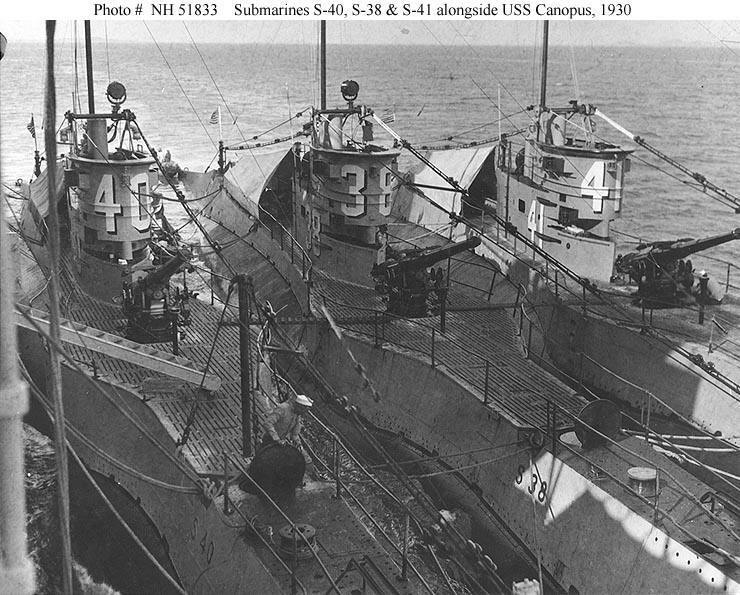
Figure 45. USS S-38 (SS-143) nested between sister submarines S-40 (SS-145), at left, and S-41 (SS-146), at right, alongside USS Canopus (AS-9) off Tsingtao, China, in 1930. Note these submarines' 4"/50 deck guns.
Subsequent submarine development, when politically and financially possible, followed a very divergent course. While the S-boats followed some lessons learned in the Great War, the developments to come did not always follow lessons or logic.
The T-class consisted of 3 boats of 268’ length and 1100 tons displacement. While capable of 20 knots surfaced (in theory) the diesels proved to be too heavy, too weak, and too unreliable. The T-class boats’ handling characteristics could be called awkward at best. Initial sea trial deemed these boats as slow and dangerous to themselves[21].
With the notoriety of the German navy’s Untersee boots still in the public (read Congress’s) memory, the class following T became the V-class. Actually several distinctly separate classes, the original 342’ 2000 ton V-boats barely survived the Washington Naval Treaty as well as internal politics. As many of the semi-informed felt ASDIC rendered the submarine obsolete, much infighting went into the continuation of submarine development in any form[22].
The first three V boats sat on the builders’ ways for several years and were finally launched in 1926. Slow, leaky, and difficult to maneuver, the large boats were meant to fill the position of submersible cruisers[23]. Later given actual names, this class set the original tradition of naming submarines after fish or marine mammals. B-1, B-2, and B-3, (or V-1, V-2, and V-3) built in the low point of military funding in the 1920s (1925-1926) eventually gained the names Barracuda, Bass, and Bonita. These boats were of surface ship proportions with a length of 342’6” and a surface displacement of 2000 tons. Due to difficulties in finding reliable American built engines, these were built with German M.A.N. (Maschinefabrik-Augsburg-Nürnberg) 6700 h.p. diesels and 2400 h.p. electric motors, the B-class could attain 18 knots surfaced and a
.jpg)
Figure 46. USS V-3 (SF-6, later renamed Bonita)
one hour submerged sprint of 11 knots[24]. At 11 knots surfaced, the Barracuda class could cruise for 10,000 nautical miles[25]. This class meant to take its war to some one else and not wait for the enemy to come to it. With a crew of 80, four forward torpedo tubes and two aft, these boats began the “Fleet boat” concept. Unfortunately, the performance of these boats and reliability of their engines ranked just as poor as their predecessors.[26]
Next came the solo V-4 class boat. Later called the A-class because of its name, Argonaut, this 2170 ton behemoth’s primary mission was minelayer. With the four forward tubes of the previous V-boats, Argonaut’s two stern tubes were replaced with a mine laying tube, room to store 60 mines, and an extremely complicated mechanism meant to compensate for the weight of the mines as they were dropped[27]. Argonaut also carried two 6” gun (one forward, one aft) for surface engagements and a crew of 89. Since the M.A.N. engines had failed to produce, Argonaut was equipped with two 3175 h.p. diesels and two 2400 h.p. electric motors[28]. Due to her huge size, Argonaut reportedly could not get out of her own way.
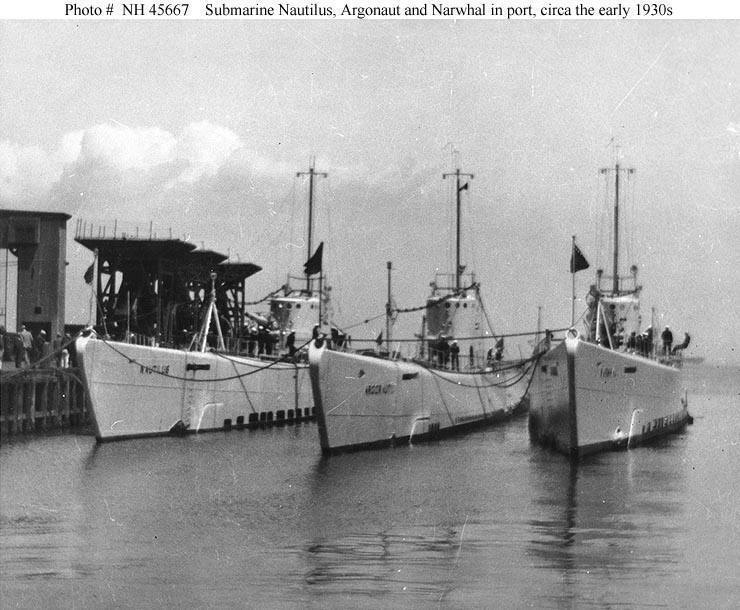
Figure 47. USS Nautilus (SS-168); USS Argonaut (SM-1); and USS Narwhal (SS-167) (listed left to right) Tied up together in port, circa the early 1930s.
Following the V-4 (Argonaut) came V-5 and V-6. Meant to be cruisers capable of hiding underwater, these boats were built around their 6” guns. With twice the fuel load of the original V-boats, these two “N-class” boats (Nautilus. and Narwhal) were monsters of the sea. With 2730 tons displacement and a length of 371’ these boats pushed the limit of the name “boat”. Crewed by 100 men, these boats even had to resort to carrying extra torpedoes outside the pressure hull. Beneath the raised gun decks, storage tubes for torpedoes were built[29]. The task of moving these torpedoes into the boat to use on patrol with any seas on was impossible. With 5450 h.p. diesels and 2540 h.p. electric motors, these boats cruised for 18,000 miles. Like all previous. V-boats, the N-class could not dive quickly or handle well[30].
The next V-boat came of the ways in 1930. V-7 (or Dolphin) was built with the realization that submarines could not keep up with the fleet. The mission would require a

Figure 48 V-7 Dolphin.
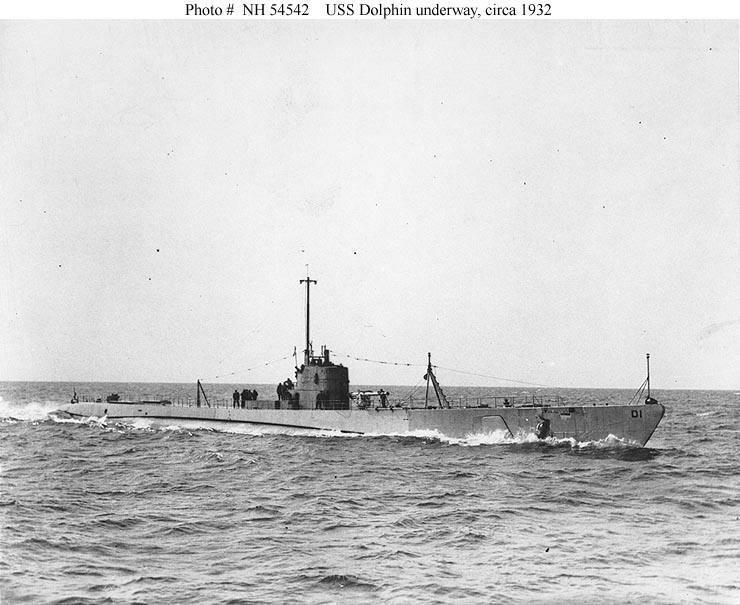
Figure 49. USS Dolphin (SS-169) underway, circa 1932.
boat of long range and good speed to act as scout. Scaled down from the previous monstrosities, Dolphin displaced 1,540 tons and carried six forward torpedo tubes as well as two aft tubes[31].
The final boats tagged with the V-classification hit the water in 1933 and 1934. Cachalot and Cuttlefish were of 1,100 tons. The M.A.N. diesels installed had been license built by the U.S. Navy. Too heavy for such small boats, they also proved unreliable and underpowered. Scaled down Dolphins, these boats did bring one significant new item, the TDC (Torpedo Data Computer)[32].
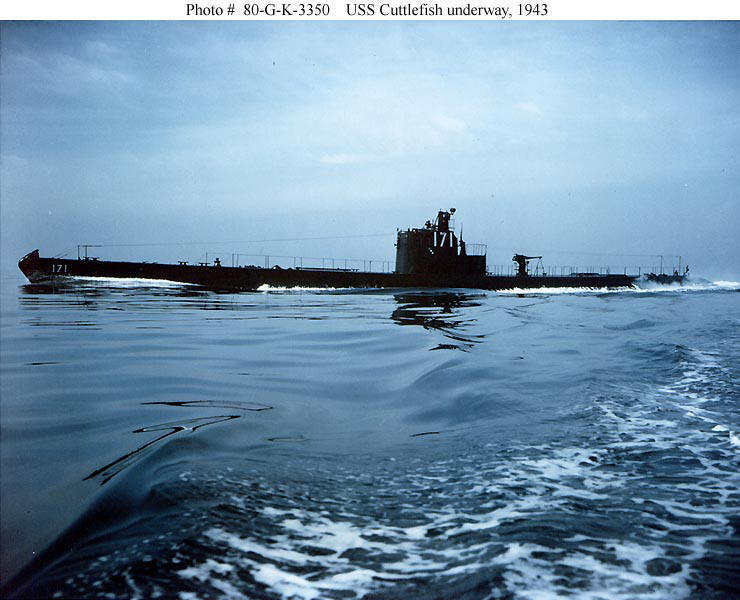
Figure 50. USS Cuttlefish (SS-171) underway, circa mid-1943, while serving on training duty out of New London, Connecticut.
As former Assistant Secretary of the Navy, President Franklin Roosevelt used the needs of the Navy as one of his methods of recovery from the massive Depression wracking the nation. His National Recovery Act included a Naval building program which itself included building 26 submarines. Commissioned between 1935 and 1939, these 26 consisted of ten P-class boats and sixteen S-2 (or Salmon) class boats. With the primary difference being riveted (P-class) or welded (Salmon) hulls, these Depression designs introduced the diesel-electric propulsion system[33].
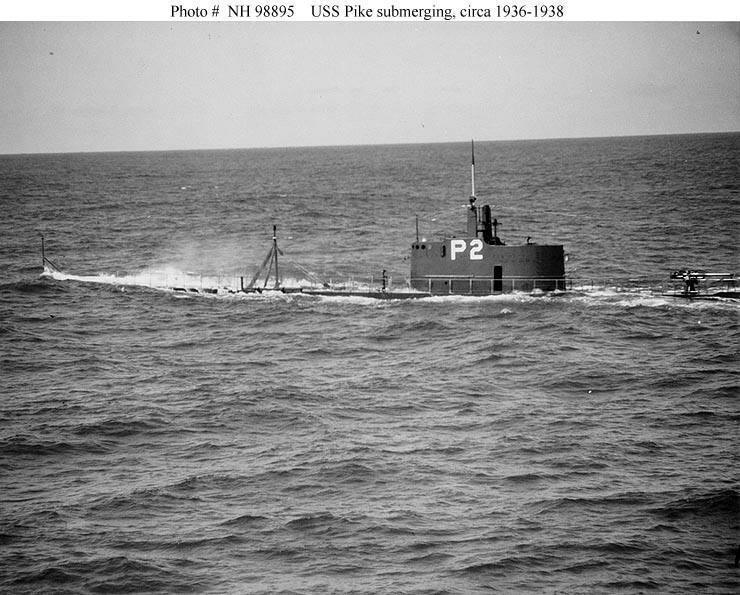
Figure 51. USS Pike (SS-173) submerging, circa 1936-1938.
The P-boats ranging from 1310 to 1330 tons, carried 4 forward and 2 stern tubes with a maximum of 20 knots surfaced and 9 knots submerged. For reasons not remembered, the P-class was subdivided into P-1, P-3, and P-5 classes[34].

Figure 52. USS Stingray (SS-186), foreground Operating in formation with other submarines, during Battle Force exercises, circa 1939. The other three submarines are (from left to right): Seal (SS-183); Salmon (SS-182) and Sturgeon (SS-187).
The introduction of the Salmon class was considered to be the point of entrance for the World War II “fleet” boat. While not truly boats capable of operating with the fleet, this class introduced the size, range, handling, and speed characteristics which defined the World War II fleet boat. Immediately following the Salmons, the Sargo class was the Salmon class all over again with very slight modifications[35].
The 1938 Submarine Officers Conference, chaired by CDR Lockwood, brought refined requirements that led to the next class. Lockwood and his contingent demanded a submarine with better diesels, six forward and four stern torpedo tubes, a larger load of reload torpedoes, improved TDC, new Kleinschmidt water distiller, longer, thinner periscope, 5” deck gun and range at fleet cruise speed of 12,000 miles[36].
What they got (along with two Mackerel class boats to please RADM Hart) was a class of submarines powered by GM-Winton/Fairbanks-Morse diesels capable of 21 knots surface, 10 knots submerged. It was 310’ long and displaced 1500 tons. With good sea keeping, great handling, and excellent habitability, these new boats could “crash dive” to periscope depth in 35 seconds[37]. This new dream boat was the Tambor class[38].
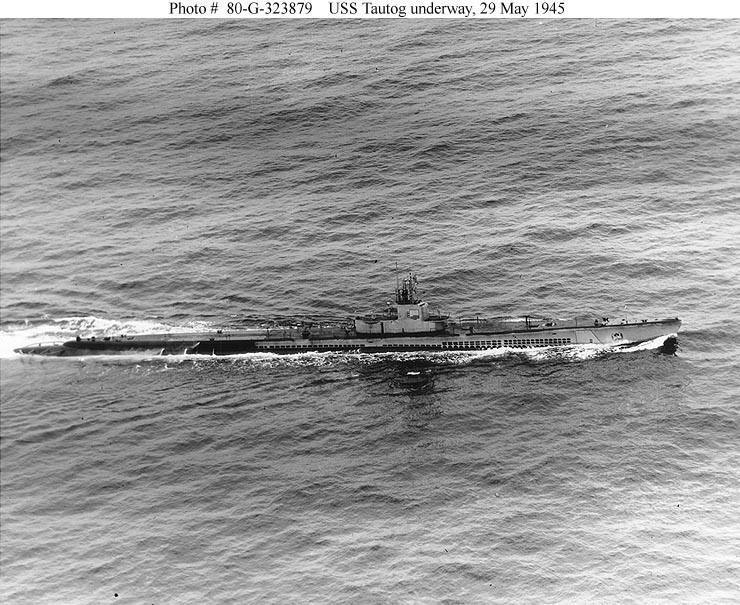
Figure 53. USS Tautog (SS-199) underway at sea, 29 May 1945. No longer able to withstand depth charges, Tautog serves here as a training boat. Note the scoreboard painted on her conning tower, representing the 26 Japanese ships sunk by Tautog.
The afore mentioned Mackerel class was a return to 825 ton boats. With a crew of 42, length of 253’, these boats had no real transpacific range or speed (16 knots surfaced, 11 submerged)[39]
The last of the real pre-war class boats was the unluckiest class. Of the six Gar class boats, only Gar herself survived the war[40]. With 6500 h.p. diesel electrics, the Gar class topped out at 21 knots surfaced and 11 knots submerged. They were equipped with six forward and four stern tubes, they displaced 1475 tons and were 253’ in length[41].
The final three classes of submarine the U.S. Navy fought World War II with are considered extensions of one on the other. The Navy settled on the Gato class in 1941 and continued it in production till improved hull steel became available, which turned the Gatos (1941-1944 construction) into Balao (1943-1944 construction) class boats[42]. Further improvements in internal arrangement made the Balao class into the Tench[43] class (1944-1945 construction). The big differences were in design depth, the depth which design engineers calculated the submarine could operate. The Gatos could go to 300’ and the Balao to 400’ while Tench could safely exceed 600’ in depth[44]. The Balao class introduced the bathythermograph, a device which monitored the ocean temperature,
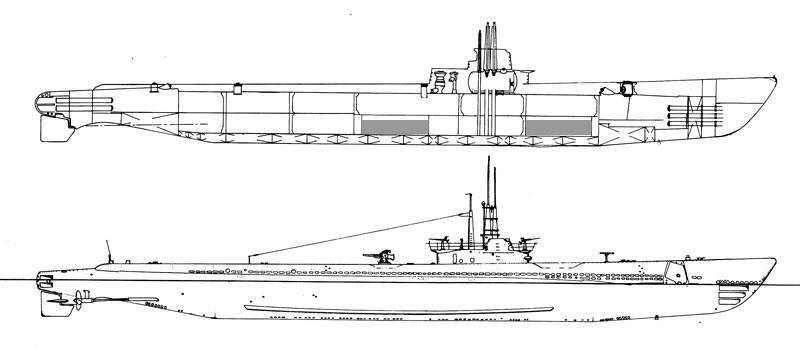
Figure 54. Gato class submarine.

Figure 55. The Gato class USS Robalo (SS-273) hits the water with a huge splash, during her launching at Manitowoc Shipyards, Manitowoc, Wisconsin, 9 May 1943. Note the inclination gage mounted on her hull side. Due to the shipyard being on a river, the boats were launched broadside as pictured here.
allowing the crew to detect any thermoclines (changes in water temperature which in turn affect the sound propagation in water). While not introduced in the Gato class, starting with this class welding was used to the exclusion of riveting, increased hull strength, watertight integrity, underwater speed, while reducing noise[45].
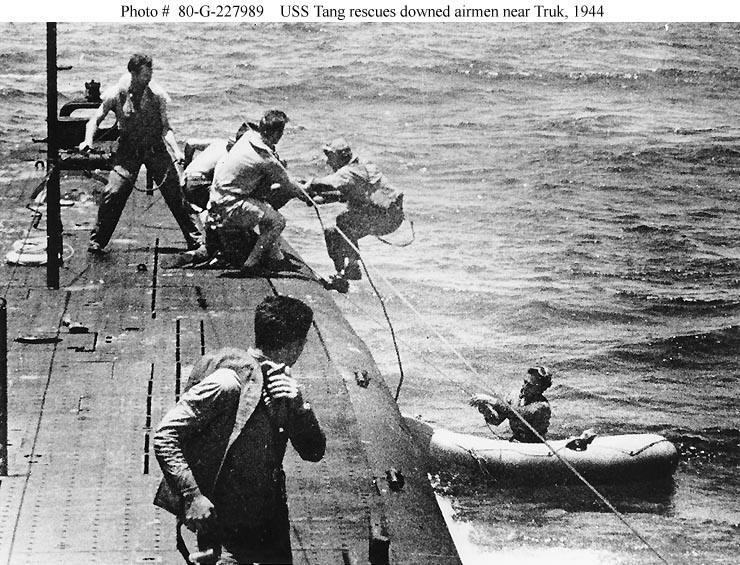
Figure 56. The Balao class submarine USS Tang (SS-306) takes aboard aircrewmen of downed aircraft and of a USS North Carolina (BB-55) OS2U floatplane that had landed to rescue them, off Truk on 1 May 1944. The OS2U Kingfisher was carrying her two man crew and picked up another 7 downed pilots. Unable to take off, Tang came to the rescue. Tang sank the OS2U afterwards. Tang was serving as lifeguard submarine during the 29 April-1 May carrier strikes on Truk rescuing a total of 22 airmen.

Figure 57. USS Torsk (SS-423), a Tench class boat.
While the U.S. Navy held production to one basic design, the Gato and its derivatives, the German Navy uncharacteristically developed 4 types of Coastal boats, 5 types of Long Range boat (which included the “most victorious.” Type IXB), and 5 Atlantic type boats (including the workhorse the Type VIIC – 568 boats commissioned in this class). To go with these war patrol boats were added the Type IA, Type VIID minelayers, Type VIIF torpedo transport (capable of carrying 13 torpedoes to fire and an additional 39 as cargo), the U-Flak boats, the Type XB minelayer, and the Type XIV Milchkuh supply boat. The more exotic German boats included the Type XXI Elektro boat (a true submarine vice submersible), the Type XXIII Elektro boat (so crammed with gear it carried only two torpedoes), as well as the Walther research boats[46].
[1] Naval History Center. “John P. Holland (1841-1914)” (www.history.navy.mil http://www.history.navy.mil/photos/pers-U.S./U.S.pers-h/j-hollnd.htm) 04 April 2005.
[2] The issue of where to place the ballast tanks then was outside the pressure hull “saddle” style, or as a second hull around the pressure hull. The debate on the correct solution continues to this day. U.S. nuclear boats are double hulled while many of the diesel electric boats today are saddle style.
[3] Jeffery B. Lake. The Lake Submarines (www.simonlake.com http://www.simonlake.com/html/u_s__lake_subs.html) 04 April 2005.
[4] Ibid.
[5] Blair. 9.
[6] Ibid. 7.
[7] Steven Trent Smith. Wolf Pack: the American Submarine Strategy that Helped Defeat Japan (Hoboken NJ: John Wiley & Sons) 2003. 38.
[8] Blair. 14.
[9] Ibid. 15.
[10] Feb 1917 – 536,000 tons sunk, Mar 1917 – 603,000 tons sunk, Apr 1917 – 9000,000 tons sunk.
[11] Padfield. 8-9.
[12] Where the P-class boats went no one knows. Records do not indicate the reasoning P was skipped.
[13] Blair. 19.
[14] Answer.com (www.answer.com http://www.answers.com/topic/washington-naval-treaty) 04 April 2005.
[15] Padfield. 17.
[16] Nobelprize.org (http://nobelprize.org/index.html http://nobelprize.org/peace/laureates/1912/root-bio.html) 04 April 2005 Blair. 30.
[17] The London Naval Treaty just was a repeat of the Washington Naval Treaty as far as submarine issues were concerned. Padfield. 17-38.
[18] Padfield. 8.
[19] S-1 class consisted of 24 boats (S-1, S-18, and S-20 thru -41) with 800 tons surfaced displacement. Their crew of 50 shoehorned into a boat 219’3’ in length with 4 forward torpedo tubes and eight reloads. The 1200 h.p. diesels drove these boats at 14.5 knots surfaced while the 1500 h.p. electric motors could propel the boat at 11 knots (for one hour) submerged. The seven S-11 class displaced 790 tons surfaced. The 231’ length held crews of 44 men. With 4 bow tubes, the S-11’s were driven by 2000 h.p. diesels (max speed of 15 knots) and could give one quick dash of 10.5 knots submerged with 1200 h.p. electric motors. The S-42 class of 6 boats displaced 850 tons surfaced and squeezed 51 men into its 225’3” length. Capable of 14.5 knots surfaced and 11 knots maximum submerged, The S-42s carried 1200 h.p. diesels and 1500 h.p. electric motors. S-48 served in World War II as the sole boat in its class. With a surface displacement of 1000 tons and a length of 267’ S-48 carried a crew of 51 to fire its 4 forward tubes and one rear torpedo tube. Engine and speed wise, there was no change in the S-48 from the S-41s. Six S-boats did not return from patrol in World War II. Most unfortunately, S-26 and S-28 were sunk by friendly fire.
[20] Clancy, Patrick “Ships of the U.S. Navy, 1940-1945: SS—Submarines” HyperWar (www.ibiblio.org/hyperwar/index.html#U.S.N. http://www.ibiblio.org/hyperwar/U.S.N./ships/ships-ss.html) 23 January 2005.
[21] Blair. 22.
[22] Ibid. 22-23.
[23] Ibid. 36.
[24] The maximum submerged speed was defines as the speed that could be maintained for one hour but totally drain the batteries.
[25] Clancy.
[26] Blair. 36.
[27] Ibid., 36.
[28] Clancy.
[29] Blair., 36.
[30] Clancy.
[31] Blair. 37.
[32] Ibid. 39.
[33] Ibid. 43.
[34] Clancy.
[35] Ibid.
[36] Blair. 46.
[37] Ibid. 58.
[38] Consisting of the submarines Tambor, Tautog, Thresher, Triton, Trout, and Tuna, this class on a combined 70 war patrols together sank 80 ships with a total tonnage of 258,237 tons. The average of 13 ships per submarine is a better showing than any other class of boats the U.S. Navy sent to sea in the Pacific. Tautog sank the record 26 Japanese ships. Triton and Trout were both lost to enemy action with Triton being the only boat in her class not to make at least 10 war patrols. Tuna was the only to sink less than 10 Japanese ships and still brought in a respectable 4 kills. (The average using 1284 ships sunk by 263 submarines gives 4.88 ships sunk per submarine)
[39] Clancy.
[40] Still, the class accounted for 41 Japanese vessels sunk with Grayback and Gudgeon killing more than 10 each.
[41] Ibid.
[42] Ibid.
[43] Tim Lanzendörfer. “U.S. Submarines” The Pacific War: The U. S. Navy (www.microworks.net/pacific/ http://www.microworks.net/pacific/ships/submarines/) 25 April 2005.
[44] Maritime Park Association, “U.S.S. Pompanito” (www.maritime.org http://www.maritime.org/tech.htm) 24 February 2005.
[45] Robert A. Germanski, CE1, U.S.N. “The Silent Service: Submarines in World War II”
(www.chinfo.navy.mil/navpalib/wwii/ http://www.chinfo.navy.mil/navpalib/wwii/facts/subs.txt) 25 March 2005.
[46] Guâmundur Helgason. “U-boat Types” uboat.net (uboat.net/index.html http://uboat.net/types/index.html) 5 February 2005.